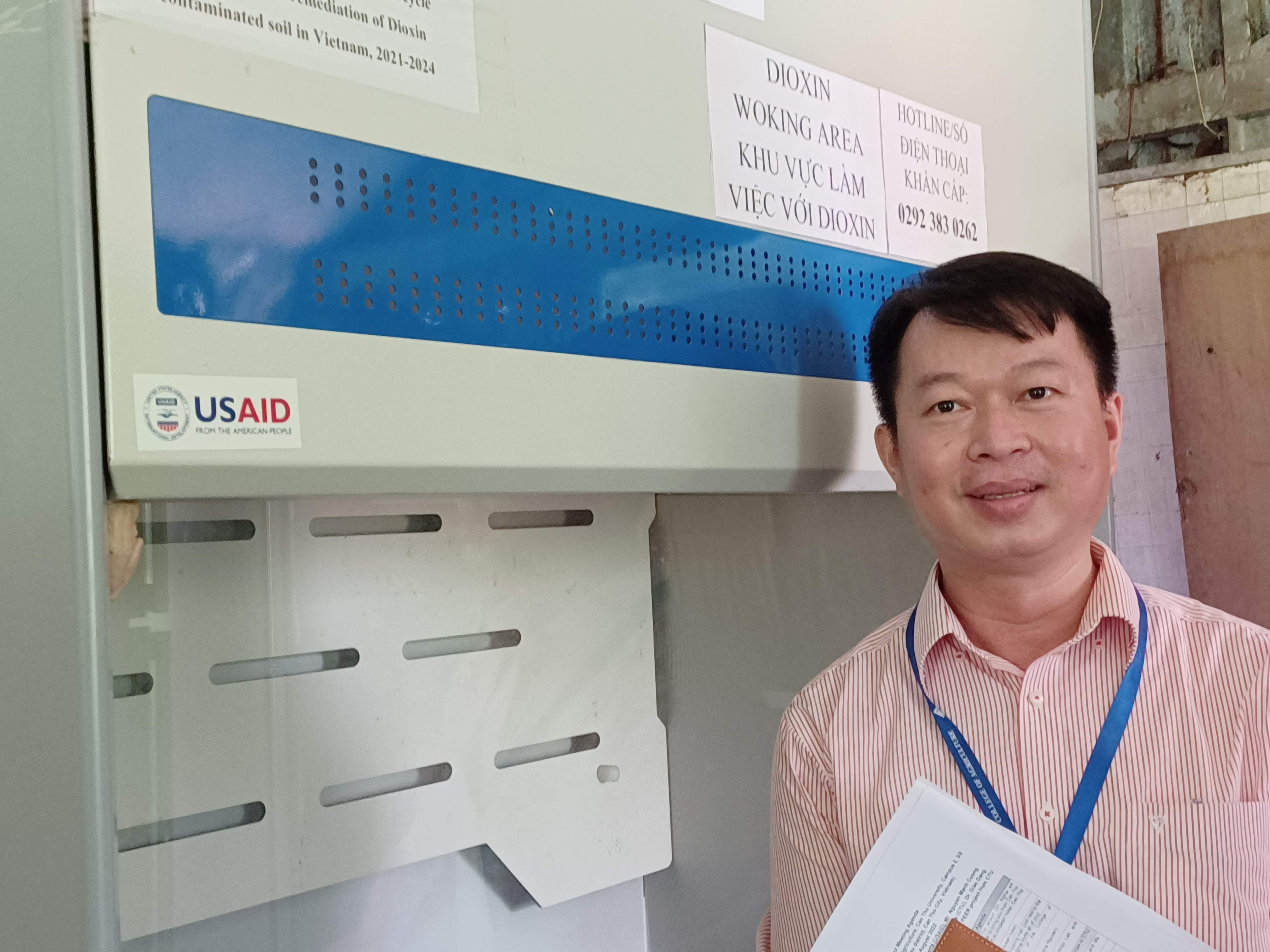|
Cycle 9 (2020 Deadline)
Developing a framework for the identification of soil limiting factors for bioremediation of dioxin compounds in contaminated soils of Vietnam
PI: Nguyen Khoi Nghia (nknghia@ctu.edu.vn), Can Tho University
U.S. Partner: M. Scott Demyan, The Ohio State University
Project Dates: April 2021 - June 2024
Project Overview
 | | Dr. Nghia in his lab with a new fume hood purchased with PEER funds. Photo credit: Dr. Nghia |
In Vietnam, soil contaminated with dioxin has been detected in many areas, especially in and immediately surrounding the Bien Hoa, Da Nang, and Phu Cat airbases. Although dioxin concentration in these soils is much lower than before, there are still significant impacts on the environment and ecosystem health. This PEER project sought to develop a framework for site-specific, synergistic bioremediation approaches to decontaminate soils containing low concentrations of dioxin (between 20-1000 ppt) in Vietnam. The PI Dr. Nghia and his colleagues aimed to accomplish this through identifying soil limiting factors regulating and preventing successful remediation of dioxins and test biostimulation and biosurfactant strategies to alleviate site-specific limiting factors.
Developing these strategies should help to address a major environmental health issue for local stakeholders by means of soil and water quality improvement, giving the local people the opportunity to use the bioremediated soils for beneficial uses such as crops, livestock, and forests, which in turn should eventually increase their income. The data collected from this project will also advance the body of research about the limiting factors of bioremediation strategies of soil dioxin and will be helpful for developing a framework for site-specific bioremediation approaches of biostimulation and biosurfactants.
Final Summary of Project Activities
The COVID-19 pandemic meant researchers could not access the Bien Hoa Airbase or other airbases for soil samples, so another PEER project team shared their samples of dioxin-contaminated soil from Bien Hoa, Da Nang, and Phu Cat airbases to analyze the current concentration of dioxin in these airbases. The researchers found the concentration of dioxin residues in the soil at A Luoi and Bien Hoa airbase was higher than at Phu Cat airbase.
The team analyzed the physical, chemical, and biological properties of the soil samples in the lab to determine the limiting factors of soil properties for the degradation of dioxins. In a separate experiment, the team isolated biosurfactant-producing bacteria from three dioxin-contaminated soil samples collected from Bien Hoa, Da Nang and Phu Cat airbases. They found interesting results for the use of Pseudomonas aeruginosa bacterial strains to achieve almost complete biodegradation of dibenzofuran (DF) after 30 days of incubation. The researchers also isolated three dibenzofuran-degrading microbial communities that degraded a very high percentage of dibenzofuran in the liquid MSM medium supplemented with 100 ppm DF after 21 days. They continued to compare the efficacy of different approaches in soil treatment and developed a dioxin bioremediation approach, that used a combination of coal slag, enriched dioxin-degrading communities or dioxin-degrading bacterial strains as bioremediation agents, bio-surfactant producing bacterial strains as dioxin bioavailability enhancer, chemical fertilizer as a biostimulator, organic material as a food source for microbes, and hydrogen peroxide as the oxygen supplier. This synergistic approach was tested in the lab and showed very promising effectiveness.
The PEER team published papers and conducted a workshop on their findings, as well as attended seminars on infrared reflectance spectrophotometry and curriculum development from the US partners. They shared their findings at the International Conference on Environmental Pollution, Restoration, and Management and a Ministry of National Defense workshop on treating and minimizing the effects of residual toxic chemicals/dioxins. The team received nine new grants, worth a total of $149,000, for their work from funders such as The Australian Centre for International Agricultural Research and The International Center of Tropical Agriculture (CIAT).
Publications
Nghia Khoi Nguyen, Duyen Thao Vy Vo, Thi Xa Le, Lois Wright Morton, Huu-Tuan Tran, Javad Robatjazi, Hendra Gonsalve W. Lasar, and Hüseyin Barış Tecimen. 2024. Isolation, and selection of indigenous potassium solubilizing bacteria from Vietnam Mekong Delta rhizospheric soils and their effects on diverse cropping systems. Biocatalysis and Agricultural Biotechnology 58: 03200. https://doi.org/10.1016/j.bcab.2024.103200
Thanh Q.C. Nguyen, Huy B. Tran, Nghia K. Nguyen, Nhut M. Nguyen, and Giao H. Dang. 2023. Removal efficiency of dibenzofuran using CuZn-zeolitic imidazole frameworks as a catalyst and adsorbent. Green Processing and Synthesis 12(1): 20228112. https://doi.org/10.1515/gps-2022-8112
Lois Wright Morton, Nghia K. Nguyen, and M. Scott Demyan. 2023. Salinity and acid sulfate soils of the Vietnam Mekong Delta: Agricultural management and adaptation. Journal of Soil and Water Conservation 78(4): 85A-92A. https://doi.org/10.2489/jswc.2023.0321A
Thanh H. V. Luong, Thao H. T. Nguyen, Binh V. Nguyen, Nghia K. Nguyen, Thanh Q. C. Nguyen, and Giao H. Dang. 2022. Efficient degradation of methyl orange and methylene blue in aqueous solution using a novel Fenton-like catalyst of CuCo-ZIFs. Green Processing and Synthesis 11:71-83. https://doi.org/10.1515/gps-2022-0006
Back to PEER Cycle 9 Grant Recipients
|
|
|
|




